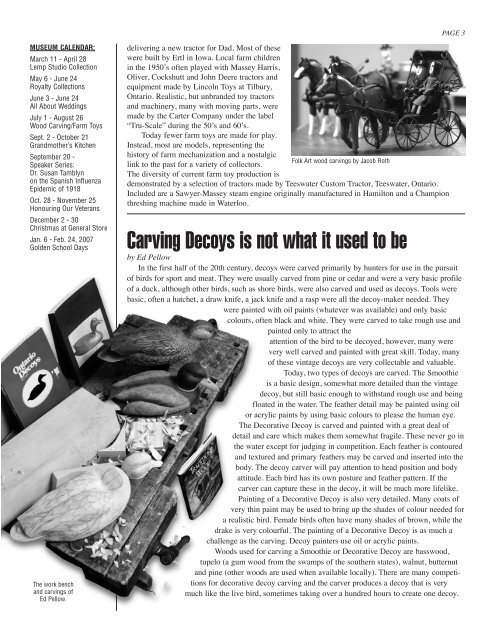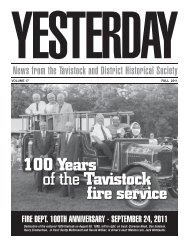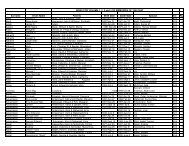to download the PDF file. - Tavistock & District Historical Society
to download the PDF file. - Tavistock & District Historical Society
to download the PDF file. - Tavistock & District Historical Society
You also want an ePaper? Increase the reach of your titles
YUMPU automatically turns print PDFs into web optimized ePapers that Google loves.
PAGE 3<br />
MUSEUM CALENDAR:<br />
March 11 - April 28<br />
Lemp Studio Collection<br />
May 6 - June 24<br />
Royalty Collections<br />
June 3 - June 24<br />
All About Weddings<br />
July 1 - August 26<br />
Wood Carving/Farm Toys<br />
Sept. 2 - Oc<strong>to</strong>ber 21<br />
Grandmo<strong>the</strong>r’s Kitchen<br />
September 20 -<br />
Speaker Series:<br />
Dr. Susan Tamblyn<br />
on <strong>the</strong> Spanish Influenza<br />
Epidemic of 1918<br />
Oct. 28 - November 25<br />
Honouring Our Veterans<br />
December 2 - 30<br />
Christmas at General S<strong>to</strong>re<br />
Jan. 6 - Feb. 24, 2007<br />
Golden School Days<br />
The work bench<br />
and carvings of<br />
Ed Pellow.<br />
delivering a new trac<strong>to</strong>r for Dad. Most of <strong>the</strong>se<br />
were built by Ertl in Iowa. Local farm children<br />
in <strong>the</strong> 1950’s often played with Massey Harris,<br />
Oliver, Cockshutt and John Deere trac<strong>to</strong>rs and<br />
equipment made by Lincoln Toys at Tilbury,<br />
Ontario. Realistic, but unbranded <strong>to</strong>y trac<strong>to</strong>rs<br />
and machinery, many with moving parts, were<br />
made by <strong>the</strong> Carter Company under <strong>the</strong> label<br />
“Tru-Scale” during <strong>the</strong> 50’s and 60’s.<br />
Today fewer farm <strong>to</strong>ys are made for play.<br />
Instead, most are models, representing <strong>the</strong><br />
his<strong>to</strong>ry of farm mechanization and a nostalgic<br />
Folk Art wood carvings by Jacob Roth<br />
link <strong>to</strong> <strong>the</strong> past for a variety of collec<strong>to</strong>rs.<br />
The diversity of current farm <strong>to</strong>y production is<br />
demonstrated by a selection of trac<strong>to</strong>rs made by Teeswater Cus<strong>to</strong>m Trac<strong>to</strong>r, Teeswater, Ontario.<br />
Included are a Sawyer-Massey steam engine originally manufactured in Hamil<strong>to</strong>n and a Champion<br />
threshing machine made in Waterloo.<br />
Carving Decoys is not what it used <strong>to</strong> be<br />
by Ed Pellow<br />
In <strong>the</strong> first half of <strong>the</strong> 20th century, decoys were carved primarily by hunters for use in <strong>the</strong> pursuit<br />
of birds for sport and meat. They were usually carved from pine or cedar and were a very basic pro<strong>file</strong><br />
of a duck, although o<strong>the</strong>r birds, such as shore birds, were also carved and used as decoys. Tools were<br />
basic, often a hatchet, a draw knife, a jack knife and a rasp were all <strong>the</strong> decoy-maker needed. They<br />
were painted with oil paints (whatever was available) and only basic<br />
colours, often black and white. They were carved <strong>to</strong> take rough use and<br />
painted only <strong>to</strong> attract <strong>the</strong><br />
attention of <strong>the</strong> bird <strong>to</strong> be decoyed, however, many were<br />
very well carved and painted with great skill. Today, many<br />
of <strong>the</strong>se vintage decoys are very collectable and valuable.<br />
Today, two types of decoys are carved. The Smoothie<br />
is a basic design, somewhat more detailed than <strong>the</strong> vintage<br />
decoy, but still basic enough <strong>to</strong> withstand rough use and being<br />
floated in <strong>the</strong> water. The fea<strong>the</strong>r detail may be painted using oil<br />
or acrylic paints by using basic colours <strong>to</strong> please <strong>the</strong> human eye.<br />
The Decorative Decoy is carved and painted with a great deal of<br />
detail and care which makes <strong>the</strong>m somewhat fragile. These never go in<br />
<strong>the</strong> water except for judging in competition. Each fea<strong>the</strong>r is con<strong>to</strong>ured<br />
and textured and primary fea<strong>the</strong>rs may be carved and inserted in<strong>to</strong> <strong>the</strong><br />
body. The decoy carver will pay attention <strong>to</strong> head position and body<br />
attitude. Each bird has its own posture and fea<strong>the</strong>r pattern. If <strong>the</strong><br />
carver can capture <strong>the</strong>se in <strong>the</strong> decoy, it will be much more lifelike.<br />
Painting of a Decorative Decoy is also very detailed. Many coats of<br />
very thin paint may be used <strong>to</strong> bring up <strong>the</strong> shades of colour needed for<br />
a realistic bird. Female birds often have many shades of brown, while <strong>the</strong><br />
drake is very colourful. The painting of a Decorative Decoy is as much a<br />
challenge as <strong>the</strong> carving. Decoy painters use oil or acrylic paints.<br />
Woods used for carving a Smoothie or Decorative Decoy are basswood,<br />
tupelo (a gum wood from <strong>the</strong> swamps of <strong>the</strong> sou<strong>the</strong>rn states), walnut, butternut<br />
and pine (o<strong>the</strong>r woods are used when available locally). There are many competitions<br />
for decorative decoy carving and <strong>the</strong> carver produces a decoy that is very<br />
much like <strong>the</strong> live bird, sometimes taking over a hundred hours <strong>to</strong> create one decoy.













